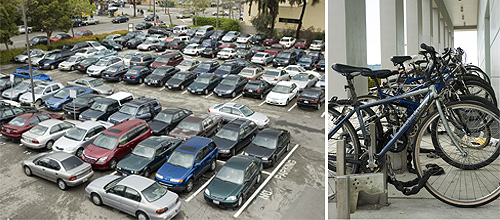Berkeleyan
 The problem (above left) and at least a part of the solution (right). The Tang Center parking lot is full before 9 a.m. most days; the same is true at most lots around campus. With the number of students, staff, faculty, and visitors expected to rise dramatically in the years ahead, a newly released bike plan aims to ease the pressure.(Deborah Stalford photos) |
Pedal power to the people
Campus's first-ever bicycle plan charts a path toward greater reliance on non-motorized, two-wheeled commuting
![]()
| 13 April 2006
Davis may lead the pack when it comes to bicycle-friendly UC campuses, but Berkeley is moving to close the gap with a comprehensive, 10-year plan aimed at making it easier to get to, from, and around the central campus via pedal power.
A draft of Berkeley's first-ever bicycle plan has just been released by Parking and Transportation, which is seeking comments through May 8. The sweeping, 108-page plan addresses bike-related issues from paths, racks, and campus construction to links with local bicycle networks and regional transit systems.
"Despite the challenges of topography on its hillside site," declares the draft, "UC Berkeley aims to be a model bicycle-friendly urban campus."
Roughly 4,200 staff, faculty, and students - nearly one in 10 of the campus total - bike to campus daily, according to the most recent transportation surveys, completed in 2000 and 2001. Based on 2000 census data, that compares favorably to rates for Berkeley residents, about 5.6 percent of whom commute by bike, and all of Alameda County, where barely one in 100 commuters bikes to work.
That said, Berkeley remains largely a car culture, as evidenced by the often-stiff competition for limited on-campus parking spots. While more than half of all Berkeley students walk to school, that's a mirror image of faculty and staff, more than half of whom drive an otherwise-empty automobile. The profusion of cars, in turn, has driven campus planners to continue looking for new ways to encourage the use of transit alternatives, including BART, buses, and bicycles, individually or in various combinations. (The draft plan recommends, for example, that BearTransit and AC Transit change their current policies to allow bikes inside buses evenings and weekends at the driver's discretion; that the entire BearTransit fleet (including replacement buses) be equipped to accommodate bikes; and that the university work with rapid-transit officials to increase bike parking at BART stations.)
With the campus population expected to swell to 51,000 by the year 2020, Berkeley's Long-Range Development Plan, issued in early 2005, set a goal of maintaining the current 10 percent rate of bicycle use - a goal that translates to a net increase of some 50 riders a year. Kira Stoll, the campus's transportation planner and a leader in drafting the new bike plan, says it was created with an eye toward meeting that target, but that its authors hope to exceed it.
The plan offers a road map for making the campus's physical infrastructure more accommodating to bike riders - closing gaps in existing bikeways, adding and upgrading bike racks, and improving lighting, among other recommendations - but also for launching a number of education and outreach programs that aspire to "weave bicycle riding into the fabric of the campus and the adjacent community."
The project has been a concerted effort by what Stoll calls "a really dedicated group of people on campus, as well as folks from the community, who've been formulating ideas for the past four or five years." Funding was provided by the Alameda County Transportation Improvement Authority through Measure B, a half-cent sales tax approved by voters in 2000 to finance bicycle and pedestrian improvements throughout the county.
One key to the plan is the concept of "integrating bicycling into the design and construction that's going to be going on on campus over the next 15 years," Stoll explains. "We wanted to really bring bicycling to the forefront, so that when the campus looks at redesigning a building, they're not just looking at bicycle flow and bicycle parking during the construction period, but building in bicycle parking and access to those new facilities."
The plan calls for continuing to allow bikes everywhere on campus except the existing dismount zone from Sproul Plaza to Moffitt Library, while filling in the gaps of the bike network both on campus and on adjacent streets. It also proposes adding nearly 1,000 new bicycle-parking spaces and suggests a number of incentives for would-be bicyclists, ranging from equipment discounts to shower facilities.
The total price tag for the 10-year plan is an estimated $1.2 million, with high-priority projects - including 273 new bike-parking spaces, bikeway upgrades, pavement markings, and signage to be completed during the first five years - expected to cost around $310,000.
"Funding is always the challenge," notes Kate Bolton, an assistant campus landscape architect and the project manager for the bike plan. "It's almost more difficult than the physical challenges."
Development of the plan, however, is a crucial step toward financing the needed improvements. "Lots of granting agencies won't even consider your requests if you don't have a master plan," Bolton says.
Parking and Transportation will hold a pair of public-information sessions, led by Stoll and Bolton, on Thursday, April 20, from 4:30 to 5:30 p.m. and from 6 to 7 p.m., in the Class of '42 Room at the Tang Center, 2222 Bancroft Way.
The public-review period ends on May 8. For a copy of the draft plan, including instructions on how to provide comments, go to the Parking and Transportation website at pt.berkeley.edu.

